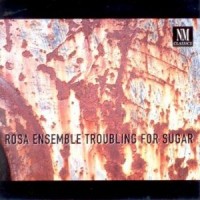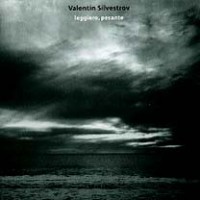Walt’s Ratatouille 6.
|
Walt Mundkowsky [July 2002.] Rosa Ensemble: Troubling for Sugar. Rosa Ensemble (Matthijs Berger, violins; Daniel Cross, percussion, keyboards; Karen Moll van Charante, piano; Karlijn Scheepers, saxophones). NM Classics 92118 (2001) [61:38]. Utrecht’s Rosa Ensemble is another of the category-crossing bands that renders the New Music scene in Holland so vital. No repertory for sax-violin-piano-percussion exists; this enterprising CD is a mix of commissioned and modified items, and both persuade. Paul Bruinen’s R.E.M. (1998) traces a dream state. Live playing intersects with taped; so do the group’s sharp vs. sustained sounds. Low harp (guest Idske Bakker), rippling piano and chimes give way to winding soprano sax and repeated violin bowings. These combos keep undercutting each other: A floating string melody is buried under insistent piano and percussion. Striking duos key the argument — unison sax / violin, piano supporting violin harmonics or trading single notes with harp. Delicacy never impedes momentum, and the absurdist where-are-we-now ending brings a smile. Será (Paul Termos) moves in mechanistic units — hammered rhythms on drum or piano, shrill sax or violin outbursts. By cleverly juxtaposing or overlapping these cells, Termos creates electric surprises. The slide into lyricism had me thinking Copland, not “a theme of Latin American glow” as intended. I don’t seek out Andriessen’s driving minimalism, but Hout (Wood, 1992) is quite attractive. Substituting a violin for the original’s electric guitar lightens the texture, and the score’s intricacies are easily followed. (Each musician lags 1/16 of a beat behind the preceding player.) I can enjoy this game of skill — Reich’s Clapping Music writ large — and Karlijn Scheepers’ facility on baritone sax is a treat. Only Peter van Onna’s Crystal Dreams (1991, rev. 1995) doesn’t require the full quartet. A fragile, halting dialogue for soprano sax and piano, its distance from Hout couldn’t be greater. The considerable beauty of line avoids complacency, thanks to some honks and overblowing from Scheepers, and frequent lacunae hold emotion at arm’s length. Daniel Cross’ Hoboken opens and closes with lengthy tapes of traffic sounds. These images of activity nudge the music to bouts of improvisatory frenzy. Scheepers’ baritone again hits the mark, in elephant-dance mode with thumping percussion or aiding Matthijs Berger’s subtly launched violin leads. Elegant recorded sound and packaging. (Purchased at a “dollar a pound” parking-lot sale in Greeley, CO. [Thanks, Ed.] Get yours via Verge [www.vergemusic.com], a superb Uxbridge, Ontario source for unusual CDs.) Voci: Works by Luciano BERIO and Sicilian Folk Music. Kim Kashkashian (viola), Robyn Schulkowsky (percussion); Radio Symphonieorchester Wien, Dennis Russell Davies (cond.). ECM New Series 1735 461 808-2 (2001) [69:42]. Early ECM New Series recitals often joined contemporary works and standard-repertory pieces. It was sound marketing, but some of the couplings didn’t register and the familiar scores weren’t always solidly prepared. Kim Kashkashian’s CD of Kurtág and Schumann (1508 437 957-2, 1995) triumphed all around, though. Her latest takes a different course: a craftsman and his raw material. Berio’s Voci (1984) is subtitled Folk Songs II, but I see little relation to his famous 1964 cycle for Cathy Berberian (still listed, on import RCA 09026 62540 2). Kashkashian is at the heart, with three widely spaced percussionists arrayed laterally. The orchestra is split in two — before and behind the soloist. (My Lambda Signature headset conveys this plan only intermittently.) Starting with a keening vocal-like attack, Kashkashian roughens her highly focused tone to accommodate Berio’s sources. Delicious episodes abound — tunes both sinuous and searing, slinky dance passages and chaste melody, glancing bow strokes among pizzicati. The often-busy orchestration envelops without obscuring (some tuttis or percussion gunshots aside). But even the undoubted sophistication can’t build these songs into a unified whole, and Voci doesn’t end, it stops. (The unbroken 32:09 timing feels too long for the ground covered.) In 1985-86 Berio revisited this turf from an angle I find much more compelling. Naturale is a dance score, and employs only viola, a spare percussion part, and a Sicilian singer the composer recorded. The conceptual gain is clear. Kashkashian retains center stage, but as commentator; the main actor (who keeps breaking in on her delivery) is the disembodied voice. More of her immense arsenal is called upon here and she appears happy to comply, adding an intense “catch” in her bowing to second the hoarse wail on tape. Ranging from gritty double-stopping to ghostly high-altitude flights (and lingering at a steady stream of song), Kashkashian fulfills the theatrical side. (“Berio considers both [ballet and concert] versions equally valid,” according to the notes.) Between these works, we get location recordings (1955-69) of several folk numbers. Not to put too fine a point on the matter, ragged bellowing is the prevailing style. (A group of children playing in the background of “Ninna nanna” somewhat redeems it.) Annotations require two booklets. Kashkashian fans need not hesitate. Valentin SILVESTROV: leggiero, pesante. Rosamunde Quartett (Andreas Reiner, Simon Fordham, violins; Helmut Nicolai, viola; Anja Lechner, cello); Maacha Deubner (soprano), Silke Avenhaus, Silvestrov (piano). ECM New Series 1776 289 461 898-2 (2002) [70:30]. Valentin Silvestrov (b. 1937, Kiev) is hardly obscure; the Fifth Symphony (1980-82), his signature effort, has received four recordings. I’d give his current manner a split decision — admiration for his sound world (“from afar, listening raptly”) and emotional reach, but annoyance with the sadistic time spans. This CD of chamber works has no competition at present, and it’s good enough to sketch a portrait of the oeuvre. Alas, the strongest music is here the least successful. String Quartet No. 1 (1974) is often called a crucial transition; summation fits better. The triadic memories in the introduction recall “Death and the Maiden” or the “Heiliger Dankgesang” from Beethoven’s Op. 132. They will return, damaged and altered (from G-major to A-flat major, a semitone higher). Elsewhere the quartet sinks into discord — isolated snapping motifs, spooky non-vibrato patches that suggest organ stops, the lead violin’s calls for order. The young Rosamunde Quartett (ECM’s house outfit) is a long step down from the sinewy, prismatic slant of the dedicatees, Kiev’s Lysenko Quartet, whose 1980 taping (BMG / Melodiya 74321 49959 2, deleted) can haunt one for days. Silvestrov is above all a composer of echoes: “Essentially, as I understand it, an epilogue-like quality is a particular feature of culture.” He has applied the Postlude tag to a family of pieces; this trio (1981-82) forms a sequence. No. 1’s tinkling piano and wordless vocal lie uneasily close to New Age, but the solo-violin No. 2 has more gravitas. Fordham runs a secure pace, but a tougher attack (à la the Lysenko’s Anatoli Bazhenov) wouldn’t come amiss. The gorgeous finale is the shortest of the three, a song for cello (not baritone) and piano accompaniment. Timbre, dynamics, and duration — Silvestrov’s concerns these days — get obsessive space on the first and last tracks. Sonata for Violoncello and Piano (1983) is barely a sonata; its aim is to steer the piano, through artful pedaling, onto the cello’s sound plane. (Rumbling triplets create a resonant haze.) As it loses energy, becoming slower and softer, it actually gains momentum. The end — murmuring cello, a piano death rattle — is poetic. Silvestrov himself achieves a similar effect on Hymn 2001. The simplest lines are stretched to 6:27, summoning a favorite book title, Bill Bathurst’s How to Continue. ECM plans further Silvestrov discs. With perceptive notes, this one makes a worthy start.
[More Walt Mundkowsky, Walt's Ratatouille]
[Previous Article:
Recordings Alone: Part II, Silence & Speech]
[Next Article:
Playing In Tongues: New And Improvised Music]
|


